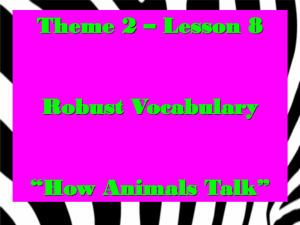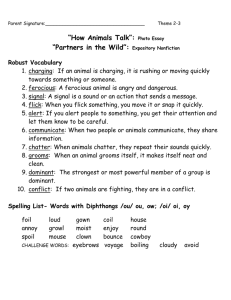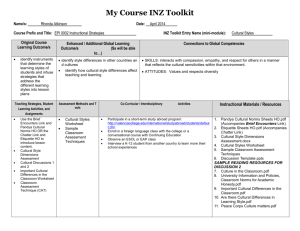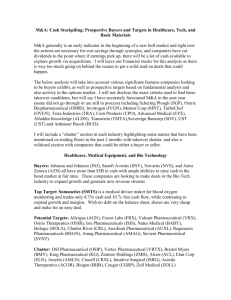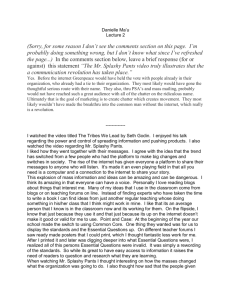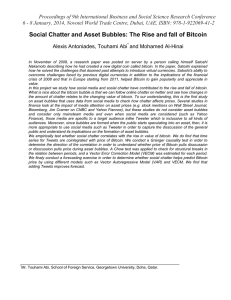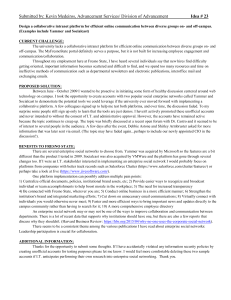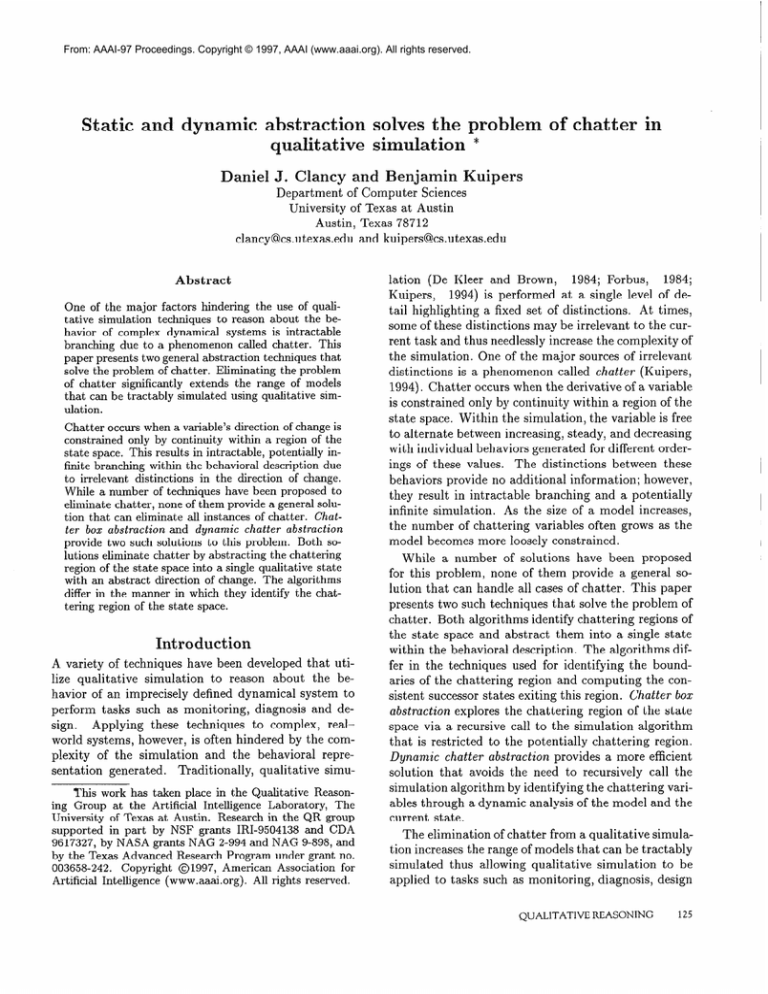
From: AAAI-97 Proceedings. Copyright © 1997, AAAI (www.aaai.org). All rights reserved.
Static
and dynamic
Daniel
abstraction
s
gualit at ive s
J. Chancy
and
es the problem
Benjamin
of chatter
i
Kuipers
Department
of Computer
Sciences
University
of Texas at Austin
Austin, Texas 78712
clancy@cs.utexas.edu
and kuipers@cs.utexas.edu
Abstract
One of the major
factors
hindering
the use of qualitative
simulation
techniques
to reason
a,bout
the behavior
of complex
dynamical
systems
is intractable
branching
due to a phenomenon
called
chatter.
This
paper
presents
two general
abstraction
techniques
that
solve the problem
of chatter.
Eliminating
the problem
of chatter
significantly
extends
the range
of models
that can be tractably
simulated
using qualitative
simulation.
Chatter
occurs
when a variable’s
direction
of change
is
constrained
only
by continuity
within
a region
of the
state
space.
This
results
in intractable,
potentially
infinite
branching
within
the behavioral
description
due
to irrelevant
distinctions
in the direction
of change.
While
a number
of techniques
have been proposed
to
eliminate
chatter,
none of them provide
a general
solution that can eliminate
all instances
of chatter.
Chatter box abstraction
and
dynamic
chatter
abstraction
provide
two such solutions
to this problem.
Both
solutions
eliminate
chatter
by abstracting
the chattering
region
of the state
space into a single
qualitative
state
with
an abstract
direction
of change.
The algorithms
differ
in the manner
in which
they identify
the chattering
region
of the state
space.
Introduction
A variety of techniques
have been developed
that utilize qualitative
simulation
to reason about
the behavior of an imprecisely
defined dynamical
system to
perform
tasks such as monitoring,
diagnosis
and design.
Applying
these techniques
to complex,
realworld systems, however, is oft’en hindered
by the complexity
of the simulation
and the behavioral
representation
generated.
Traditionally,
qualitative
simuThis
work
has taken
place
in the Qualitative
Reasoning Group
at the Artificial
Intelligence
Laboratory,
The
University
of Texas
at Austin.
Research
in the QR group
supported
in part
by NSF
grants
IRI-9504138
and CDA
9617327,
by NASA
grants
NAG
2-994 and NAG
9-898,
and
by the Texas
Advanced
Research
Program
under
grant
no.
003658-242.
Copyright
01997,
American
Association
for
Artificial
Intelligence
(www.aaai.org).
All rights
reserved.
lation
(De Kleer and Brown,
1984; Forbus,
1984;
Kuipers,
1994) is performed
at a single level of detail highlighting
a fixed set of distinctions.
At times,
some of these distinctions
may be irrelevant
to the current task and thus needlessly increase the complexity
of
the simulation.
One of the major sources of irrelevant
distinctions
is a phenomenon
called chatter (Kuipers,
1994). Chatter occurs when the derivative
of a variable
is constrained
only by continuity
within a region of the
state space. Within
the simula,tion,
the variable is free
to alternate
between increasing,
steady, and decreasing
with individual
behaviors
generated
for different
orderings of these values.
The distinctions
between
these
behaviors
provide no additional
information;
however,
they result in intractable
branching
and a potentially
infinite
simulation.
As the size of a model increases,
the number
of chattering
variables
often grows as the
model becomes more loosely constrained.
While
a number
of solutions
ha,ve been proposed
for this problem,
none of them provide
a general solution that can handle all cases of chatter.
This paper
presents two such techniques
that solve the problem
of
chatter.
Both algorithms
identify
chattering
regions of
the state space and abstract
them into a single state
within the behavioral
description.
The algorithms
differ in the techniques
used for identifying
the boundaries of the chattering
region and computing
the consistent successor states exiting this region.
Chatter box
abstruction
explores the chattering
region of the state
space via a recursive
call to the simulation
algorithm
tha.t is restricted
to the potentially
chattering
region.
Dynamic
chatter abstraction
provides
a more efficient
solution
that avoids the need to recursively
call the
simulation
algorithm
by identifying
the chattering
variables through
a dynamic
analysis of the model and the
current
state.
The elimination
of chatter from a qualitative
simulation increases the range of models that can be tractably
simulated
thus allowing
qualitative
simulation
to be
applied to tasks such as monitoring,
diagnosis,
design
QUALITATIVE
REASONING
125
and tutoring.
For example,
Rickel and Porter( 1994) required the techniques
presented
here to simulate complex models automatically
generated
from a large scale
knowledge
base to answer prediction
questions
within
the field of botany.
(0 inc)
and
Qualitative
Definition
1 (Event
branch)
An event occurs when a variable
reaches a landmark
its derivative
becomes zero).
or becomes steady (i.e.
An event branch occurs when there are multiple
events
following
a time-interval
state whose ordering
is unconstrained
by the model.
Definition
2 (Chatter
branch)
A chatter
branch
occurs following
time-point
ti if there exists a variable
v that is currently
steady whose direction
of change
is constrained
only by continuity.
A three way branch
occurs depending
upon whether the variable is increasing, decreasing
or steady in the interval
(ti: &+I) -(see
figure 1).
This paper describes
two solutions
to the problem
of
chatter.
The problem
of event branching
has been
addressed
by the model decomposition
and simulation (DecSIM)
algorithm
(Clancy and Kuipers,
1997a).
DecSIM partitions
the model into loosely coupled components and simulates
the components
independently
to eliminate
irrelevant
distinctions
between unrelated
variables.
Chatter
branching
is problematic
due to the repetitive nature of the phenomenon.
Since the variable’s
direction
of change is unconstrained,
the variable is free
to become steady again after the chatter branch and
the process repeats itself. While some behaviors
exit
AUTOMATED
REASONING
/
((OA*)
inc)
._
(A* inc)
(A* std)
;l\.
’
(iA*)djc)
4
(A* dec)
Simulation
Both of the algorithms
presented
have been developed as extensions
to the QSIM simulation
algorithm
(Kuipers,
1994). QSIM describes the behavior
of a dynamical
system via a tree of alternating
time-interval
and time-point
states called a behavior
tree.
Each
state specifies a qualitative
magnitude
and a direction
of change (qdir) for each variable
within
the model.
The direction
of change corresponds
to the sign of the
variable’s
derivative
and can be increasing
(inc),
decreasing
(dec) or steady (std).
The qualitative
magnitude
is either a landmark
value or an interval
between two landmarks
defined upon a totally
ordered
quantity
space of landmark
values.
Landmarks
many
be defined during
the simulation
to represent
critical
points identified
within
the simulation.
A branch occurs within the behavioral
description
whenever
there
is insufficient
information
within
the model to identify a unique successor to a given state. Two types of
branches can occur:
126
_
(0 std)
(0 dec)
Chatter
-
Qualitative
value transitions
consistent with continuity
within the closed interval (0 A*) are identified
by arcs
within the figure.
The boxed area denotes the chattering region of the state
space (i.e. a chatter box). Once the system enters this
region of the state space, the chattering variable can continue to cycle within the box.
If landmarks are introduced,
the simulation
can remain
within the boxed region for an infinite number of states
since additional
qualitative
distinctions
are introduced
whenever the variable becomes steady.
Figure
1: Possible qualitative
value transitions
for a
QSIM variable.
the unconstrained
region of the state space, others will
continue cycling between different
values for the direction of change for an arbitrary
number
of qualitative
states resulting
in an infinite
simulation
(see figure 2).
Chatter
branching
is particularly
difficult
to eliminate due to the propagation
of chatter
through
the
model. Once one variable,
~1, begins to chatter and its
derivative
changes sign, it is possible that the derivative of another
variable,
~2, that is related
to vl will
also become unconstrained,
so v2 begins to chatter.
This process can repeat itself resulting
in a large number of chattering
variables
within
one region of the
state space called a chatter box.
Definition
3 (Chatter
box)
For a model with a set
of variables
V, a region of the state space is defined
as a chatter box with respect to a set of variables
VC
if the derivatives
of variables
in VC are unconstrained
with respect to variables
in V - V,.
A state exits a chatter
box when a non-chattering
variable
changes value or when a chattering
variable
changes qualitative
magnitude
and enters into a constrained
region of the state space.
The phenomenon
of chatter
becomes more complicated if a landmark
exists within
the unconstrained
region of the state space and the magnitude
of the
variable
is unconstrained
around this landmark.
This
phenomenon
is called landmark
chatter and it results
in changes in both the magnitude
and the direction
of
change for the chattering
variable.
A special case of
landmark
chatter,
called chatter around zero, occurs
when a variable
and its derivative
are represented
explicitly
within a model and both of them exhibit
chatter. In this case, the derivative
variable
will chatter
amount
__
.._
.
._
E__
amount
(A)
I
(B)
Netflow
I
t
I
(B)
:o A A 43
Netflow
w
CC)
(4
e In a qualitative
model
of three
tanks
arranged
in sequence
connected
by tubes
(a), NetjIowB(t)
= InfEourB(t)
- OutfEowB(t).
Th e d erivative
of Netf 1owB is constrained
only by continuity
within
the time-interval
following
the
initial
state.
o The
simulation
branches
on all possible
trajectories
of
NetflowB(t)
while
all other
variables
are completely
uniform.
The
simulation
is infinite
in nature
due to chatter and must
be halted
at an arbitrary
state
limit.
A
single
behavior
(c) from
the behavior
tree
(b) is displayed
demonstrating
the unconstrained
movement
of
NetjlowB(t).
e Other
qdirs)
techniques
are unable
(higher
order
derivatives
and ignoring
to eliminate
chatter
in NetflowB.
Figure 2: Intractable
branching
simu.lation
of a W tube.
due to chatter
in the
around zero as its integral
chatters.
While chattering
behaviors
may describe a real behavior of the system (Kuipers
et. al., 1991), a disjunctive enumeration
of all possible combinations
of values
Furthermore,
this enumeraprovides
no information.
tion obscures other distinctions
within the description
and can result in an infinite
simulation.
Eliminating
this source of distinctions
is essential if qualitative
simulation
is to be used to reason about complex dynamical systems.
Previous
Solutions
Two previous
methods have been developed
for eliminating chatter within a QSIM behavior
tree simulation.
The higher order deriuative (HOD)
(Kuipers
et. al.,
199 1) technique
uses the second and third order derivatives of the chattering
variables
to determine
a unique
direction
of change for unconstrained
variables
and
eliminate
spurious
behaviors.
When possible,
higherorder derivatives
expressions
are derived via algebraic
manipulation
of the constraints;
otherwise,
the operator must specify these expressions
within
the model.
This technique,
however, is not effective when an ambiguous
evaluation
of the HOD expression
results or
when an expression
cannot be derived.
Ignore qdirs (Fouch6 and Kuipers,
1991) eliminates
chatter
by ignoring
distinctions
in a variable’s
direction of change throughout
the simulation.
This technique requires
the modeler
to identify
the chattering
variables
prior to the simulation.
For many models, a
variable’s
direction
of change is ambiguous
only within
certain regions of the state space. In other regions of
the state space, direction
of change information
may
be relevant
in constraining
the behavior
of the system. Thus, ignore qdirs may result in over-a,bstraction
and generate
spurious
behaviors.
In addition,
ignore
qdirs often prevents the application
HOD constraints
to eliminate
spurious behaviors
and cannot be used to
eliminate
landmark
chatter.
DeCoste
(DeCoste,
1994) addresses chatter
when
simulating
Qualitative
Process Theory
models
(Forbus, 1984) simply by ignoring
distinctions
in the direction of change when a unique value cannot be inferred
via constraint
propagation.
He does not address the
problem
of landmark
chatter
nor does he provide
an
evaluation
of this approach.
In addition
he does not
discuss cases where constraint
propagation
is too weak
of an inference
mechanism
to infer a unique direction
of change.
Chatter
Box
Abstraction
The chatter box abstraction
algorithm
eliminates
chatter by abstracting
chattering
regions of the state space
into a single qualitative
state within t,he behavioral
description.
The chatter box abstraction
algorithm
performs the following
steps:
Step 1: Detect entry into a chatter box.
Step 2: Identify the chattering
variables.
Step 3: Create and insert into the behavior
tree
abstract states describing
the chatter box
and its successors.
The algorithm
determines
when the simulation
potentially enters a chatter box by performing
an analysis
of the constraints
within
the QDE to identify
a set
of potentially
chattering
variables.
Constraints
within
the model are used to partition
the variables
into chatter equivalency
classes (i.e. if one variable
in the class
chatters then all the variables will chatter)
and identify
classes containing
variables
that are prevented
from
chattering
throughout
the simulation.
This algorithm
QUALITATIVE
REASONING
127
is an extension
of the algorithm
used when deriving
HOD expressions
(Kuipers
et. al., 1991).
If a potentially
chattering
variable is changing within
a time-interval
state, a focused enwisionment
’ is used
to explore
the current
region of the state space and
determine
which variables,
if any, exhibit
chatter.
A
focused envisionment
is a recursive
call to the simulation algorithm
defined as follows:
Definition
4 (Focused
envisionment)
A focused
envisionment
is an attainable
envisionment
that is restricted to a specified region of the state space. States
created outside the defined region are suspended from
simulation
(i.e. their successors are not computed).
The focused envisionment
is limited
to changes in
the direction
of change for potentially
chattering
variables. The results of the focused envisionment
are analyzed to determine
which variables
actually
exhibit
chatter.
The states within the chattering
region of the
envisionment
graph are then abstracted
into a single
abstract,
time-interval
state. The direction
of change
for chattering
variables
is described
via a conjunctive
list of the possible directions
of change within the chattering region (e.g. (inc
std dec)). The successors to
this abstract
state are computed
from the boundary
states that exit the chattering
region within
the focused envisionment.
Boundary
states that are equivalent with respect to the non-chattering
variables
are
combined
to eliminate
distinctions
in variables that are
still chattering.
This occurs when a relevant distinction
occurs in a non-chattering
variable
while a chattering
variable
remains
unconstrained.
The algorithm
used
to create successor states has been extended
to handle the abstract boundary
states. Figure 3 provides an
overview
of the algorithm
with respect to the W-tube
example.
Landmark
chatter is eliminated
by extending
the region that is explored
during the focused envisionment
to include the landmark
around which chatter is possible. The QSIM behavior
language
has been extended
so that an abstract
state can describe an interval
defined by two non-adjacent
landmarks
within the quantity space.
Results
Chatter
antees.
box abstraction
(Proofs omitted
provides
the following
due to space restrictions.)
guar-
Theorem
1 Chatter box abstraction
identifies
a variable as chattering
within an abstract state if and only
if it exhibits chatter within the same region of the state
space in a standard
QSIM simulation.
‘An
envisionment
tive
states
rather
than
landmarks.
128
AUTOMATED
generates
a tree
REASONING
a finite
graph
and does
not
of qualitacreate
new
--
QDE
Behavior Tree
Before chatter
abstraction
Final Behavior Tree
o The links
in the figure
represent
jects
represent
data
structures.
dotted
line in the envisionment
qualitative
state.
and the obprocesses
Two
states
linked
by a
the same
graph represent
o Using
chatter
box
abstraction,
QSIM
generates
a single behavior.
The chatter
box state
is represented
by a
square
in the behavior
tree.
HOD
constraints
are used to
eliminate
chatter
in all of the variables
except
NetflowB.
Figure 3: Chatter
to the W-tube.
box
abstraction
algorithm
applied
Theorem
2 ‘The set of real-valued
trajectories
described by a chatter box abstracted
behavioral
description is equal to the set described
by an unabstracted
tree with respect to the non-chattering
variables
and a
super-set
with respect to the chattering
variables.
Dynamic
Chatter
Abstraction
Chatter
box abstraction
explores the entire chattering
region of the state space via simulation.
The number of states within
this region is exponential
in the
number
of chattering
variables.
Thus, exploring
this
region can become intractable
as the size of a model
grows and the number
of unconstrained
variables
increases. Dynamic
chatter
abstraction
provides
a scalable solution by avoiding the need to perform
a focused
envisionment.
Instead, the chattering
variables
within
a region of the state space are identified
by a dynamic
analysis of the model and the current state.
For each time-interval
state, dynamic
chatter
abstraction
determines
whether
the state is contained
within
a chatter
box and if so identifies
the set of
variables
that chatter
within
this region.
It uses an
understanding
of the restrictions
that are asserted by
each constraint
within the model along with the current qualitative
state to perform
this task.
For example,
in the W-tube
model
if HOD constraints
are not used, the direction
of change
for
Netf 1owB is restricted
only by the constraint
Netf 1owB
+ Flow-BC
= Flow-AB
In the time-interval
following the initial
state, all three variables
are increasing. Thus, in this state the qdir of NetflowB
is UIIconstrained
and NetflowB
is free to chatter.
Dynamic
chatter abstraction,
however, must reason
not only about the qualitative
values contained
within
the current
state, but also about
how these values
change as variables
begin to chatter.
Once NetflowB
chatters, its derivative
can change sign and the above
addition
constraint
no longer restricts
the derivative
of Flow-AB.
If Flow-AB
is not, prevented
from
chattering by other constraints,
it is free to chatter and must
be identified
as such within
the current
chatter box.
A more detailed
presentation
of the algorithm
is contained in (Clancy and Kuipers,
1997b).
Identifying
the
set of chattering
variables
The algorithm
must det,ermine if a variable ZI can chatter following
the current
time-interval
state before a
non-chattering
distinction
occurs.
If such a variable
exists, then the current
state is contained
within
a
chatter box. To address this issue, two questions
must
be answered:
Consistency
- Is there
is free to chatter?
a consistent
state
in which
ZI
Reachability
- Can this state be reached from the
current
state only through
changes
occurring
in
other chattering
variables?
Such a state is called
chatter-reachable.
To answer these questions,
dynamic
chatter
abstraction uses a chatter dependency
graph to define the conditions under which a variable can chatter with respect
to the current
state.
Two types of nodes exist within
the chatter dependency
graph (see figure 4). An equivalency node is created
for
each
set. of chatter
equivalent variables
within
the mode12.
These nodes are
connected
through
a directed
AND-OR
subgraph
of
For an equivalency
intermediate
dependency
nodes.
the leaves of the AND-OR
subgraph
node
EQs ource,
correspond
to equivalency
nodes containing
variables
related
to the variables
within
EQSOUTCe via a3 constraint
within
the model.
The AND-OR
subgraph
can be viewed as a predicate
that specifies the conditions
under which the variables
in EQSOUTCe are free
to chatter.
A consistent,
chatter-reachable
state satisfying this predicate
exists if and only if the variables in
chatter within the current region of the state
EQ source
space.
Evaluating
the dependency
graph
The dependency graph evaluation
algorithm
categorizes
chatter
equivalency
classes as chattering,
non-chattering,
or chatter-unknown.
The algorithm
iterates through
the
equivalency
classes
moving
them
from
the
2Prior
to the
chatter
equivalency
algorithm.
simulation,
classes
variables
are
as in the chatter
partitioned
into
box abstraction
For each time-interval
state,
a chatter
dependency
graph
is created
describing
the conditions
under
which
each set
of chatter
equivalent
variables
can chatter
with
respect
to
the current
state.
In the figure,
the qdir for each variable
is
displayed
within
the node.
The AND-OR
subgraph
extend-
ing from an equivalency
node EQSOurce has the following
structure:
The root
of the sub-graph
is an AMD node
that
has a
link pointing
to an OR node for each constraint
relating
a variable
within
EQSOuTCe to other variables
within
the
model.
In the W-tube,
there
are two constraints
that
can potentially
restrict
the variables
within
EQ1
from
chattering.
Each
OR node
corresponds
to a constraint
is created
for each set of qualitative
value
for the variables
within
C that
allows
the
EQ SOurce to chatter.
C.
A child
assignments
variables
in
The
children
of these
f?mal conjunctive
nodes
are the
equivalency
nodes
for the other
variables
within
C. The
arcs are labeled
with information
about
how the qualitative values
of these variables
must change
if the variables
in EQsource are to chatter.
The
most
common
labels
are same (i.e. the qdirs
must
remain
the same)
and opp
must
change
sign before
the variables
in
( i.e. the qdirs
EQSOurce can chatter.)
In the W-tube,
Cl restricts
the
variables
in EQ1 from
chattering
if and only if the qdirs
in EQ2 and EQ3 either
both
remain
the same
or both
change.
Figure
4: Chatter
chatter-unknown
categories.
dependency
category
graph
into
for the W-tube
one of the other
two
Evaluation
of a node E&l in the dependency
graph
begins by instantiated
a partial
state description
with
the current
qualitative
magnitude
and direction
of
change for the variables
within
the node and all variables currently
classified as non-chattering.
Then a
backtracking
algorithm
is used in an attempt
to identify a chatter-reachable
state that satisfies the ANDOR sub-graph
extending
from E&l.
Information
is
added to the partial
state when another
equivalency
node is encountered.
The information
added depends
upon the label of the link pointing
to the node. If the
search encounters
an equivalency
node E&z whose direction
of change is required
to change (i.e. the arc
is labeled with opp), then E&z must be classified
as
QUALITATIVE
REASONING
129
chattering
before the required
information
can be
added to the partial
state description.
This ensures
that the state is chatter-reachable.
The evaluation
algorithm
is called recursively
if EQ2 is still classified as chatter-unknown.
A cycle within
the recursive calling sequence is treated as a dead end condition
and the algorithm
backtracks.
A cycle between nodes
E&r and E&z means that along the path traversed,
E&l depends upon E&z to chatter first while E&z
depends upon E&l to chatter first. Thus, neither one
can chatter3.
This condition,
however, does not necessarily prevent these nodes from chattering
since there
might be another
set of qualitative
value assignments
(i.e. another
path in the dependency
graph) that allows one of these nodes to chatter.
Once one chatters,
the other may be free to chatter as well.
If a partial
state is created satisfying
the AND-OR
subgraph,
the QSIM constraint
satisfaction
algorithm
is used to ensure that the variable
assignments
are consistent with all of the constraints
within
the model.
If they are, then the equivalency
node is classified as
chattering.
If a chatter-reachable,
consistent
state
cannot be identified,
then the equivalency
node is classified as non-chattering.
Abstract
and
successor
state
creation
Once the set of chattering
variables
is identified,
the
algorithm
creates an abstract state with an abstracted
qdir of (inc
std dec) for each of the chattering
variables. The QSIM state successor algorithm
has been
extended
to handle such abstract
states.
Landmark
chatter
Complexity
The size of the chatter dependency
graph is polynomial
in the number of chatter equivalency
classes. Since the
evaluation
algorithm
is performing
constraint
satisfaction, we expect that the worst case complexity
of the
algorithm
may be exponential,
however,
the average
130
AUTOMATED
REASONING
Evaluation
Both the chatter box abstraction
and dynamic
chatter
abstraction
algorithms
have been empirically
evaluated
using a corpus of over 20 models obtained
from various
researchers
within
the field of qualitative
reasoning.
The results were validated
against a standard
QSIM
simulation.
Both algorithms
identify
variables as chattering if and only if they exhibited
chatter within
the
same region of the state space in the standard
simulation.
Table 1 reports
the results of this evaluation
on a subset of the models used. In all of the models
tested, dynamic chatter abstraction
performed
at least
as well as chatter
box abstraction
and often it performed
significantly
better.
Furthermore,
a number
of improvements
are planned to increase the efficiency
of the dynamic
chatter abstraction
algorithm.
In particular,
a propagation
phase will be added prior to the
dependency
graph evaluation
to reduce the complexity
of this step.
Discussion
Dynamic
chatter
abstraction
is able to handle chatter around
zero without
any additional
processing.
The algorithm
described
above does not assume that
the derivative
constraint
prevents the integral
variable
Instead,
information
about the confrom chattering.
straining
power of the derivative
constraint
is represented via labels within the chatter dependency
graph.
If both a variable
and its derivative
are identified
as
chattering,
then the derivative
variable
will exhibit
chatter around zero.
3Remember
that
the opp label requires
destination
node to change
sign before the
chatter.
case complexity
is much better.
In fact, we have not
encountered
an exponential
time factor in any of the
models tested (see table 1). This is because the algorithm
performs
a directed
search of the potentially
chattering
region simply to identify
variables
as chattering or nonchattering
as opposed to enumerating
all
possible solutions
within
this search space. Conflicts
are often encountered
well before an entire path is traversed within the search space. A detailed
complexity
analysis of the dynamic
chatter abstraction
algorithm
still must be performed.
variables
in the
source
node can
Both abstraction
algorithms
provide
unique
benefits
with respect to the elimination
of chatter.
Dynamic
chatter abstraction
provides
a scalable solution
that is
able to efficiently
solve the problem
of chatter.
However, it is less modular
than chatter box abstraction.
Since the algorithm
incorporates
information
about
how the simulation
algorithm
processes the constraints
within
the model, extensions
to the simulation
algorithm may require modifications
to the dynamic
chatter abstraction
algorithm.
On the other hand, chatter
box abstraction
uses the basic simulation
algorithm
as
its main inference
engine.
As a result, extensions
to
the simulation
algorithm
can be incorporated
without
modifications
to the chatter abstraction
algorithm.
Both abstraction
techniques
incorporate
HOD information
when applicable
and thus complement
this
technique.
With respect to ignore qdirs, the techniques
presented
here supersede
the need for this capability
since they are both able to automatically
detect chatter and selectively
eliminate
it. For larger models, ig-
Vars
Model
W Tube
Glucose-insulin
Interaction
Van der Pol EquationA
Controlled
Hot/Cold
tankA
Turgor
Stoma&
Cooling
Plant A
Heart
Model
16
11
10
14
19
15
42
A - Exhibits
chatter
around zero.
B - Oscillatory
behavior
results
in infinite
C - Could not be simulated
to completion
Chat
Vars
Number
of Behaviors
No chatter
abstraction
Chatter
abstraction
Envisionment
Behavior
Behavior
tree
tree (no lms)
1
2
4
5
7
10
28
3
155
43
24
509
659
689
behavior
tree.
due to resource
>
>
>
>
>
>
>
Simulation
limitations.
1845
2807
1788
601’
2598
4095
2784
terminated
1
41
12B
14
1
1
200
once
the structure
within
Simulation
time
Dynamic
Chatter
Chatter
0.9
14
2.3
5.0
2.4
7.7
100
3.4
52
15
48.2
20.5
418
C
the tree
(set)
ROX
could
be determined.
When
chatter
abstraction
was not used,
both
an
Each
model
was tested
both
with
and without
chatter
abstraction.
envisionment
and a behavior
tree simulation
without
landmark
introduction
were used.
The number
of behaviors
generated
are listed
above
using
a state limit
of 5000.
Note that while an envisionment
often results
in a smaller
number
of behaviors,
the total number
of qualitatively
distinct
behaviors
represented
is the same as there are an infinite
number
of paths
within
the envisionment
graph.
however,
dynamic
chatter
abstraction
performed
Both
types
of abstraction
generated
the same
number
of behaviors;
significantly
better
than chatter
box abstraction
with respect
to simulation
time.
HOD
constraints
were used whenever
applicable.
Ignore
qdirs
On other
models
ignore
qdirs
can be used,
however,
it requires
which
variables
are chattering.
does not work
a significant
on models
exhibiting
amount
of work
by
the
chatter
modeler
around
zero.
to identify
Table 1: Evaluation
of Dynamic
Chatter
and Chatter
Box Abstraction
nore qdirs requires
the modeler
to invest a significant
References
amount of time to identify
the chattering
variables and
D. 3. Clancy
and B. J. Kuipers,
1997a.
Model
Decomposition
and Simulation:
A component
based
qualitative
cannot be applied when using automatic
model buildsimulation
algorithm.
In Proceedings
from
the Fourteenth
ing (Rickel and Porter
1994). In addition,
ignore qdirs
National
Conference
on Artificial
Intelligence,
1997.
cannot be used to eliminate
landmark
chatter.
This
D.
J.
Clancy
and
B.
J.
Kuipers,
1997b.
Dynamic
Chatphenomenon
tends to happen more often as the size of
ter Abstraction:
A scalable
technique
for avoiding
irrela model increases.
evant
distinctions
during
qualitative
simulation.
In ProWhile the techniques
presented
here have been deceedings
of the Eleventh
International
Workshop
on Qualveloped
as extensions
to the QSIM
algorithm,
they
itative
Reasoning
about
Physical
Systems,
1997.
could be applied in a similar manner to eliminate
chatD. DeCoste,
1994.
Goal-directed
qualitative
reasoning
ter from Qualitative
Process Theory
(QPT)
models
with
partial
states.
Technical
Report
57, The
Institute
for the Learning
Sciences,
Northwestern
University,
1994.
(Forbus,
1984).
Conclusions
Recent
soning
discussions
within
the field of qualitative
reahave questioned
the usefulness
of qualitative
shulation when reasoning about the behavior of complex dynamical
systems. In general, these discussions
have focused on the complexity
of the simulation
and
the difficulty
of scaling up to larger, more complex systerns due to irrelevant
distinctions.
Chatter
is a major
source of these distinctions.
The techniques
presented
in this paper solve this problem.
These techniques
in
combination
with the DecSIM
component
simulation
algorithm
(Clancy
and Kuipers,
1997a) significantly
extend the range of models that can be tractably
simulated using qualitative
simulation
thus supporting
the
application
of qualitative
simulation
to tasks such as
monitoring,
diagnosis
and design for complex,
realworld systems.
J. De Kleer
and J. S. Brown,
Based
on Confluences.
In
1984.
K. D. Forbus,
Intelligence,
P. Fouche
Framework
the Fifth
ing about
1984.
Artificial
1984.
Qualitative
24:85-168,
1984.
A Qualitative
Intelligence
process
theory.
Physics
24:7-83,
Artificial
and B. J. Kuipers,
1991.
Towards
a Unified
for Qualitative
Simulation.
In Proceedings
of
International
Workshop
on Qualitative
ReasonPhysical
Systems,
295-301,
1991.
B. J. Kuipers,
1994.
Qualitative
Reasoning:
Modeling
Simulation
with Incomplete
Knowledge.
Cambridge,
MIT
Press,
1994.
B. J. Kuipers,
C. Chiu,
D. Dalle
1991.
Higher-order
derivative
simulation.
Artificial
Intelligence,
J. Rickel
and B.
Complex
Systems
appear
in Artificial
Porter,
1997.
to Answering
Intelligence,
and
MA:
Molle
and D. R. Throop,
constraints
in qualitative
51:343-379,
1991.
Automated
Prediction
1997.
QUALITATIVE
Modeling
Questions
REASONING
of
To
131

